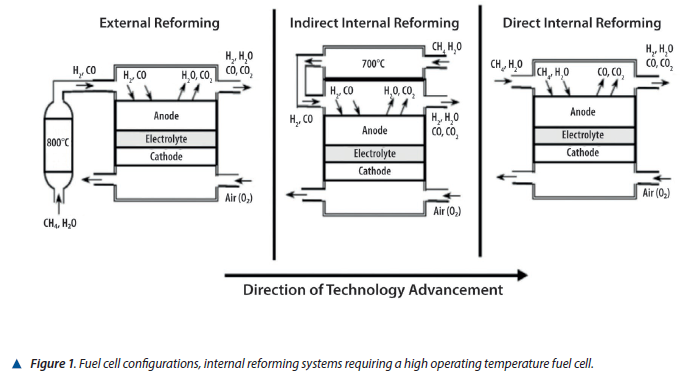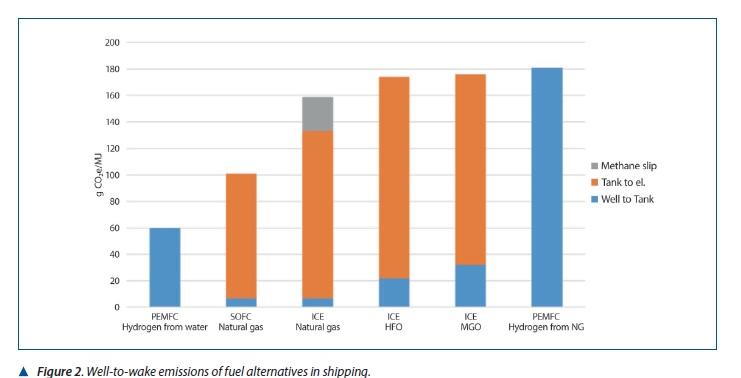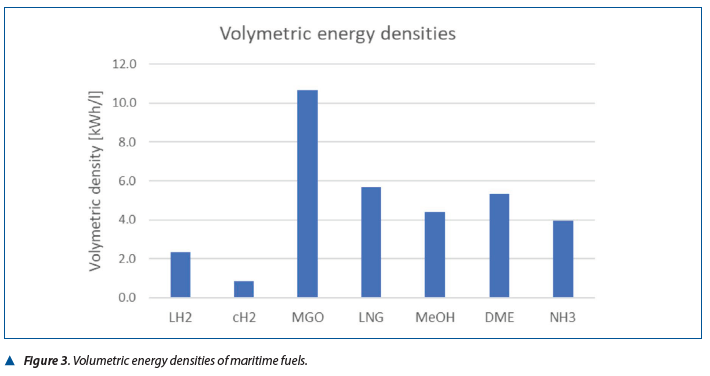26/07/2021
Hydrogen Fuel in Maritime Use
The introduction of renewable energy is a major step to improve the local and global environment and bring down costs universally around all industries. The pursuit of green energy has caused a tidal wave of technologies to sprout with the aim of improved energy economy and utilization of low-emission energy carriers. The IMO 2050 strategy to reduce emissions is one driver towards lowered emissions in the maritime field and with innovative solutions introduced towards reaching this goal, there will be economical benefits in it in the long run. Though it is good to consider a variety of proposed alternative fuels that are increasing their foothold in the industry, a simpler path to the whole story can be found from the opposite end considering well-to-wake efficiency and emissions of a ship.
Well-to-wheels means an analysis of the whole fuel supply chain and is often a reference to fossil fuels but can as well be a reference to alternative fuels, energy carriers derived from either carbon-based or fully renewable sources. The maritime take on this, well-to-wake analysis, consists of extraction of the fuel, possible refining of the fuel, transportation and bunkering, and finally energy conversion to electrical or mechanical energy to power a vessel, thus producing a wake. Coming back from the wake, energy production for a vessel is the first place to increase the efficiency of the whole supply chain.
Application
Applications for higher fuel efficiency onboard a vessel can be reached by introducing new technology or by improving the existing equipment. In a general situation, fuel efficiency on a newbuilt ship is a sum of power production and transmission. Without going into too much detail, power production is the main engine and power is transferred as mechanical, heat and electric power. For fuel efficiency, the popular solution – from internal combustion engine to mechanical power and with a generator to electric power – can be increased up to 50% but in practice is around 45%. Efficiency can be increased with additional equipment, for example a waste heat recovery system can increase the fuel efficiency of existing systems by roughly 10%. An internal combustion engine can be optimized for alternative and gaseous fuels, reaching similar fuel efficiencies.
Another fuel-based technology utilizing chemical energy is fuel cells, which convert the fuel gas directly into electricity and enable very high electrical efficiency. Different types of fuel cells allow high electrical efficiency, currently up to 60%, and are well suited in a maritime environment due to their good part load characteristics and minimum vibration and noise emissions. Fuel cells allow the possibility to reach reduced maintenance, modular and flexible design and water generation. The most attractive fuel cells for maritime use are PEMFC (polymer electrolyte membrane fuel cell) with high energy density and some maturity in the field, and SOFC (solid oxide fuel cell) with high temperature and even higher efficiency capabilities.
PEMFC has maturity in the maritime field as a trial fuel cell, resulting in good initial outcomes for the system and has led to more comprehensive testing. The PEMFC system is very simple, and due to its low operating temperature of 70 °C, the maintenance cost is low. The latest modules have a size of up to 200 kW while being physically small, with 55% fuel efficiency. PEMFC will require highly pure hydrogen fuel onboard, which will demand a hydrogen storage or onboard system for reforming purified oxygen. PEMFC uses an expensive and trademarked Nafion membrane, which does not endure higher operating temperatures. A lot of research is being concentrated in the development of high temperature PEMFC, which would overcome the high purity hydrogen demand and allow more flexible fuel utilization.
The SOFC system is a moderately sized fuel cell, capable of highly efficient energy generation from hydrogen, natural gas and renewable fuels with reduced emissions in comparison to internal combustion engines. The system requires high temperatures, 700 °C, to operate and can reach 60% fuel efficiency with a 60 kW unit. The current SOFC system’s major weaknesses are load cycling, a large and complex system and immaturity of the technology, but its fuel flexibility and efficiency encourage further development for the system. The SOFC system does not require reforming the unit to utilize light hydrocarbon fuels, such as methane and propane, or ammonia, but can utilize them as is. The high temperature in ship use allows combined heat and power use further increasing the fuel efficiency. Oxygen for both fuel cells is available from ambient air.

Maritime fuels
Maritime fuels can be divided into residual oils, or heavy fuel oils (HFO), and distillate oils with lower sulfur content (MGO, MDO). Low flashpoint fuels or more commonly alternative fuels are: Natural Gas (LNG), Ethane, LPG, Dimethyl Ether (DME), Methanol, Ethanol, Hydrogen, Ammonia. These fuels have relatively low greenhouse gas emissions and zero SOx emissions. In pursuing the lowest well-to-wake emissions, the production of a fuel, if not occurring in the nature, has a major effect on the supply chain emissions even if the operative emissions were to stay low.
Most alternative fuels are produced from hydrocarbons, but some have synthetization methods chemically (ammonia, DME utilizing hydrogen) or electrochemically (hydrogen through electrolysis). The debate about the most promising fuel for shipping purposes is intense and criticism toward all is a good habit to maintain. One thing to keep in mind is that the further processed a fuel is, the more efficiency is lost and well-to-wake emissions increase. For this article and its limited space it is good to concentrate carefully and not to get further carried away, and to minimize both operative and production emissions; hydrogen with the potential for zero CO2 emissions will be chosen as the target of examination.
Hydrogen does not appear isolated in nature. Hydrogen is generated in several different methods, most commonly by reforming hydrocarbons (natural gas) or by electrolysis through water. The origin of hydrogen can be referred to as the hydrogen rainbow, where different colors describe a variety of possible production methods. The important ones are: grey hydrogen, which is produced from natural gas mainly by steam reforming; blue hydrogen is the same as grey, but the CO2 is captured or re-used instead of released into the atmosphere; green hydrogen, which is produced with zero-carbon energy sources through electrolysis.
In 2020, the majority of hydrogen produced was grey hydrogen by 95% of all produced hydrogen. Hydrogen produced from natural gas needs three steps to reach the industrial standard of pure hydrogen, requiring, besides steam reforming, also steps through water gas shift and pressure swing adsorption, which are part of a standard hydrogen plant. This process reaches hydrogen purity for a PEM fuel cell. Hydrogen production with electrolysis is a method where water is breaking down molecularly to separate hydrogen and oxygen. Emissions of hydrogen production with electrolysis are tied to the used electricity.
Well-to-wake emissions for analysis include natural gas recovery, transportation, refinement, storage and bunkering. As combined in Figure 2, the production method for hydrogen from natural gas results in well-to-wake greenhouse gas emissions even larger than MGO and HFO when utilized in a modern four-stroke engine. The emissions from electricity used as a reference is the average Finnish electricity grid in 2020. With excess green electricity, the emissions for hydrogen production can be brought down to far lower emissions.

Hydrogen (in maritime business)
Hydrogen in maritime business brings potential for green energy but there are challenges in its utilization. As a low flashpoint fuel, risk of fire must be minimized and double-walled piping in a dedicated, well-ventilated trunk should be included. Even with heavy precautions with the fuel, it has been concluded that small hydrogen leaks are often overshadowed by the presence of air currents from ventilation, where the currents serve to disperse leaked hydrogen quickly reducing any associated fire hazard greatly. Storing hydrogen on the upper deck lowers the risk of fire in case of a leakage, as any leaking hydrogen rapidly moves up and away from potential ignition sources due to its light weight. On a ship, hydrogen storage must be well-ventilated and controlled with dedicated leak detection equipment.
The major challenge for hydrogen as a bunker fuel is the energy density. While having a high energy density by weight, hydrogen has very poor energy density by volume, forcing the bunker fuel to be either compressed up to 700 bar or liquefied. Liquefied hydrogen is stored at a low temperature of -253 °C. The liquefaction process efficiency is about 70%, while compressed hydrogen can reach 90%.
Figure 3 shows storage density of hydrogen as liquefied hydrogen LH2 and compressed hydrogen cH2 of 450 bar with other alternative maritime fuels.
Hydrogen storage is a challenging matter due to the size of hydrogen molecules, which are tiny and can diffuse through many materials considered airtight or impermeable to other gases. The diffusion rate of hydrogen increases with the tank pressure, close to 500 bar the rate nears 1% of cH2 per day. There are challenges with LH2 at bunkering and insulation due to its extreme temperature, and with poor liquefaction efficiency the compressed option is often more a viable option especially in smaller units in decentralized production, as pressurization for cH2 is simpler and more efficient than liquefaction.

Summary
Overall efficiency in shipping can be improved and emissions reduced considerably, but this process must be done carefully considering many angles. Operative emissions can be brought down with different fuel options, but well-to-wake emission and efficiency should be considered, and green alternatives prioritized in the production of alternative fuels. Further study about which fuels and power production to utilize in different shipping situations from ferries to container vessels is to be expected, as a comprehensive solution to improve shipping is not yet in sight.
